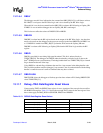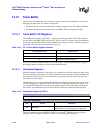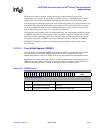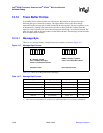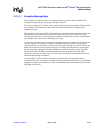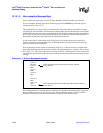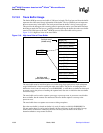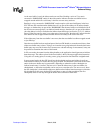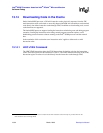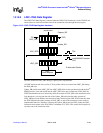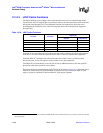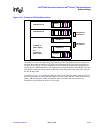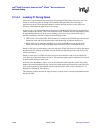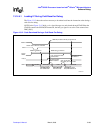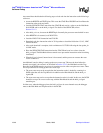
Developer’s Manual March, 2003 13-33
Intel
®
80200 Processor based on Intel
®
XScale
™
Microarchitecture
Software Debug
As the trace buffer is read, the oldest entries are read first. Reading a series of 5 (or more)
consecutive “0b0000 0000” entries in the oldest entries indicates that the trace buffer has not
wrapped around and the first valid entry is the first non-zero entry read out.
Reading 4 or less consecutive “0b0000 0000” entries requires a bit more intelligence in the host
SW. The host SW must determine whether these 0’s are part of the address of an indirect branch
message, or whether they are part of the “0b0000 0000” that the trace buffer was initialized with. If
the first non-zero message byte is an indirect branch message, then these 0’s are part of the address
since the address is always read before the indirect branch message (see Section 13.13.1.3, Address
Bytes). If the first non-zero entry is any other type of message byte, then these 0’s indicate that the
trace buffer has not wrapped around and that first non-zero entry is the start of the trace.
If the oldest entry from the trace buffer is non-zero, then the trace buffer has either wrapped around
or just filled up.
Once the trace buffer has been read and parsed, the host SW should re-create the trace history from
oldest trace buffer entry to latest. Trying to re-create the trace going backwards from the latest trace
buffer entry may not work in most cases, because once a branch message is encountered, it may not
be possible to determine the source of the branch.
In fill-once mode, the return from the debug handler to the application should generate an indirect
branch message. The address placed in the trace buffer is that of the target application instruction.
Using this as a starting point, re-creating a trace going forward in time should be straightforward.
In wrap around mode, the host SW should use the checkpoint registers and address bytes from
indirect branch entries to re-create the trace going forward. The drawback is that some of the oldest
entries in the trace buffer may be untraceable, depending on where the earliest checkpoint (or
indirect branch entry) is located. The best case is when the oldest entry in the trace buffer was
checkpointed, so the entire trace buffer can be used to re-create the trace. The worst case is when
the first checkpoint is in the middle of the trace buffer and no indirect branch messages exist before
this checkpoint. In this case, the host SW would have to start at its known address (the first
checkpoint) which is half way through the buffer and work forward from there.



